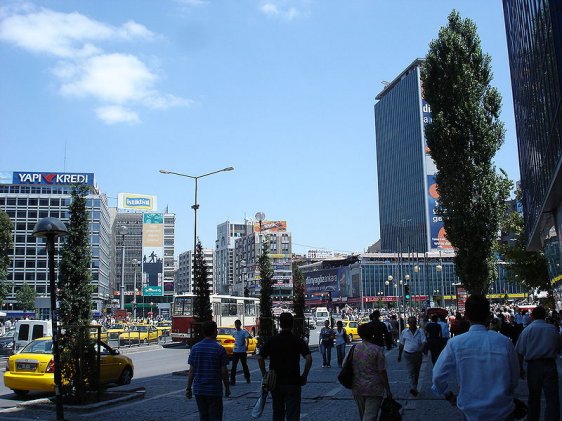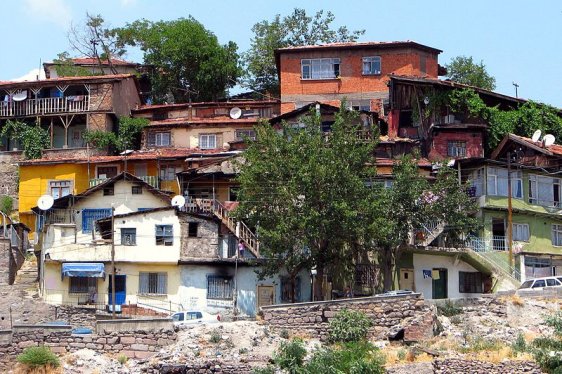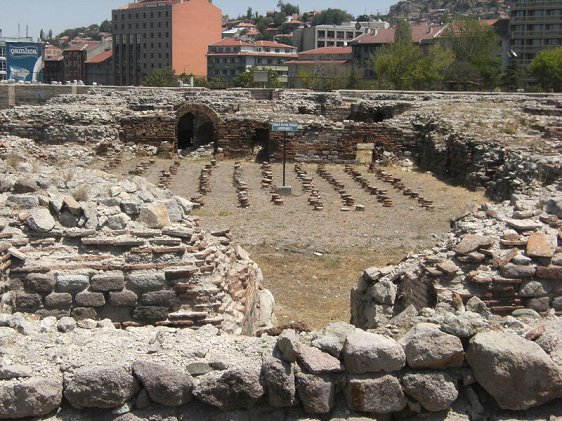 Ankara, Turkey
Ankara, TurkeySource: https://commons.wikimedia.org/wiki/File:Yumurtatepe_T%C3%BCm%C3%BCl%C3%BCs%C3%BC%27nden_%C3%A7ekilmi%C5%9F_bir_foto%C4%9Fraf.jpg
Author: Reality
Author: Reality

Ankara is the capital and second biggest city in Turkey. Located at an elevation of 938 m (3,077 ft) within Ankara Province in the region of Anatolia in central Turkey, the city covers 2,516 sq km n(971.4 sq mi) and has a population of 1.55 million people (2011 estimate). It is within the Ankara metropolitan area, which encompasses the entire Ankara Province, with a population of 4.43 million people.
 Kızılay Square in downtown Ankara
Kızılay Square in downtown AnkaraSource: https://commons.wikimedia.org/wiki/File:Ankara_Kizilay_square.JPG
Author: Ahmetan
Author: Ahmetan

Although Ankara only became the capital of Turkey when it replaced Istanbul (formerly Constantinople) on 13 October, 1923, Ankara is a very old city. The area around Ankara is rich with archaeological sites from the Hittite, Phrygian, Hellenistic, Roman, Byzantine and Ottoman periods. Surrounding the city are wills topped with ruins of an ancient fortress.
Ankara experiences a continental climate. Its summers are hot and dry while its winters cold and snowy. The hottest month is August, when the average high temperature rises to 28.3°C (82.9°F). Coldest month is January, when the average low temperature drops to -6.6°C (20.1°F). Rain is heaviest in the spring, specifically in May, which receives 52 mm (2.01 in) of precipitation.
 Old neighborhood of Ankara
Old neighborhood of AnkaraSource: https://commons.wikimedia.org/wiki/File:Viewfromoldankara.jpg
Author: ozgurmulazimoglu
Author: ozgurmulazimoglu

Human habitation in the Antara area goes back to the Bronze Age Hatti civilization. It started around the 18th century BC, reached its peak in the 14th century BC. It was replaced by the Hittites, the Phrygians, and later powers including the Lydians, Persians, Greeks, Galatians, Romans, Byzantines and Turks.
The rise of Ankara as the state capital began with the defeat of the Ottomans in the First World War. As Istanbul and Anatolia was being partitioned, Turkish leader Mustafa Kemal Atatürk established his resistance movement headquarters in Ankara and fought for Turkish independence. The victory in that war led to the signing of the Treaty of Lausanne in 1923. Through this treaty, the Turks won international recognition for the newly established Republic of Turkey to replace the Ottoman Empire.
 Remains of the Roman Bath in Ankara
Remains of the Roman Bath in AnkaraSource: https://commons.wikimedia.org/wiki/File:Ankara_Roma_Hamam%C4%B1_Hypocaust.jpg
Author: Nosferatü
Author: Nosferatü

Visiting Ankara
Foreign visitors arrive at the Ankara Esenboğa International Airport (ESB) which receives flights from Turkish Airlines, Lufthansa, Austrian Airlines and British Airways. Arriving at the airport, you can take the airport bus to the city center for 10 TL.Exploring Ankara
The Ankara metro is a two-line subway network that will help a bit in taking you around the city, although the coverage is still limited. On the other hand, getting familiar with the bus network may be a bit tricky, as the stops do not display bus maps and routes. Alternatively, the taxis are quite plentiful. Trips should be according to the meter, with flag fall at 2.20 TL and 1.90 TL for every kilometer, same rate day or night, and no tipping required.Sights & Attractions in the heart of Ankara
- Ankara's Bazaars: The city has a number of traditional bazaars where you can window shop and see how the locals go about their business. The neighborhood to visit includes Ulus/Hisar, particularly streets such as Salman Sokak, Konya Sokak and Çikrikçilar Sokak. The Coppersmith Bazaar (Bakırçılar Çarşısı) on Salman Sokak is fascinating.
- Çengelhan Rahmi M. Koç Museum: Housed in a restored 16th century caravanserai across from Ankara Castle, this museum has a disparate collection of items on display, from bicycles to scientific instruments and other seemingly unrelated items.
- Column of Julian: Roman column standing 15 m (49 ft) in height erected in AD 362 to commemorate the visit of Roman Emperor Julian.
- Ethnography Museum (Etnoğrafik Müzesi)
Museum in a beautiful white-marble mansion showcasing exquisite examples of Turkish costumes, handicrafts, rugs and woodwork. - Hacı Bayram Vali Mosque and Tomb: Mosque of the 14th century founder of the Bayrami religious sect and his tomb, located adjacent to the Temple of Augustus and Rome.
- Museum of Anatolian Civilizations: One of the best museums in Turkey, this museum exhibits artifacts related to the long history of Anatolia, from Paleolithic stone tools to sculptures and busts from different periods, to bowl, vessals, pots and other items.
- Museum of the War of Independence: Formerly the Grand National Assembly Building, now a museum displaying artifacts and memorablia related to the struggle for Turkish independence.
- Republic Museum (Cumhuriyet Müzesi)
Museum celebrating the achievements made by the country since the formation of the Turkish Republic in 1923. - Roman Baths: These baths date from the 3rd century. They are in an advanced state of ruin, but you can still view the frigidarium (cold room), tepidarium (lukewarm room) and caldarium (hot room).
- Temple of Augustus (Augustus Tapinaği)
Roman temple built in 20 BC by King Pylamenes of Galatia on the occasion of the visit of Roman emperor Augustus.
Sights & Attractions within Ankara
- Atakule: Shopping complex with a 125-m (410-ft) tower restaurant offering splendid views of the city.
- Atatürk Boulevard: The main thoroughfare through Ankara linking the Presidential Palace and government precinct with the old city.
- Atatürk Farm: The farm belonging to Atatürk, who believed in setting up parks as part of the country's heritage. The farm has a replica of the leader's boyhood home. It is set within a leafy grounds that still produces ice cream, yoghurt and other farm produce.
- Atatürk House: Home of the Father of Modern Turkey is located within the grounds of the Presidential Palace, which is not open to the public. The House however is now a museum and visitors are welcome.
- Atatürk Mausoleum: Located on a hill to the west of the city, the grim, stately monument is visited by a steady stream of Turks coming to pay their respect to Turkey's supreme leader.
- Hisar (Byzantine citadel)
Located on the northern end of the city, the Hisar is a walled area enclosing a medieval neighborhood that includes Salman Sokak, the Copper Alley, where you can find all sorts of bric-à-brac. - Kavaklıdere and Çankaya: Affluent neighborhoods with upscale shopping malls and designer boutiques.
- Kocatepe Mosque: This four-minaret replica of Istanbul's Blue Mosque is one of the biggest mosques in the world and a landmark of Ankara.
- Turkish Railway Open-Air Steam Locomotive Museum: Museum displaying locomotives and carriages. It is located near the Ankara Railway Station, which also has its own museum, the Turkish Railway Museum offering information on the history of Turkish Railway.
- Youth Park: One of the liveliest and most popular urban recreation area, with an artificial lake suitable for boating, cafés and funfair.
Sights & Attractions around Ankara
- Bolu: Area on the outskirts of Ankara covered with deciduous forest offering scenic views. This rural area produces good ewe's milk cheese and offers skiing during the winter months.
- Çubuk Dam: Dam that provides drinking water to the population of Ankara. The area is also a popular picnic area.
- Diamond Head: This is the nearest ski resort to Ankara. It is particularly popular during the winter months when the people of Ankara come here for skiing, skating and tobogganing.
- Gölbaşı Lake: Lake where you can go for an excursion or picnic.
- Gordion: Capital of ancient Phrygia from the 8th century BC is an archaeological site that can be visited. Gordion produces the legendary King Midas, whose touch turns things to gold. Among the sights here is the Gordion Museum, which exhibits artifacts from the area, and most interesting of all, Midas Tomb.
- Haymana Hot Springs: This is one of the six thermal spas around Ankara. It has been in use since Roman times.
- Infidel's Castle (Gavur Kalesi)
Ancient citadel, believed to have been built by the Hittites, with relief figures of gods and goddesses in stone. - Kızılcahamam: One of the most popular thermal spas in Ankara. It has hotels to provide accommodation for those wishing to spend the night.
- Soğuksu National Park: A forest park located at an elevation of n975 m (3,200 ft) that provides a safe and serene place for walks and relaxation away from the crowded city.
 Latest updates on Penang Travel Tips
Latest updates on Penang Travel Tips
 Map of Roads in Penang
Map of Roads in Penang
Looking for information on Penang? Use this Map of Roads in Penang to zoom in on information about Penang, brought to you road by road.
Copyright © 2003-2025 Timothy Tye. All Rights Reserved.

 Go Back
Go Back